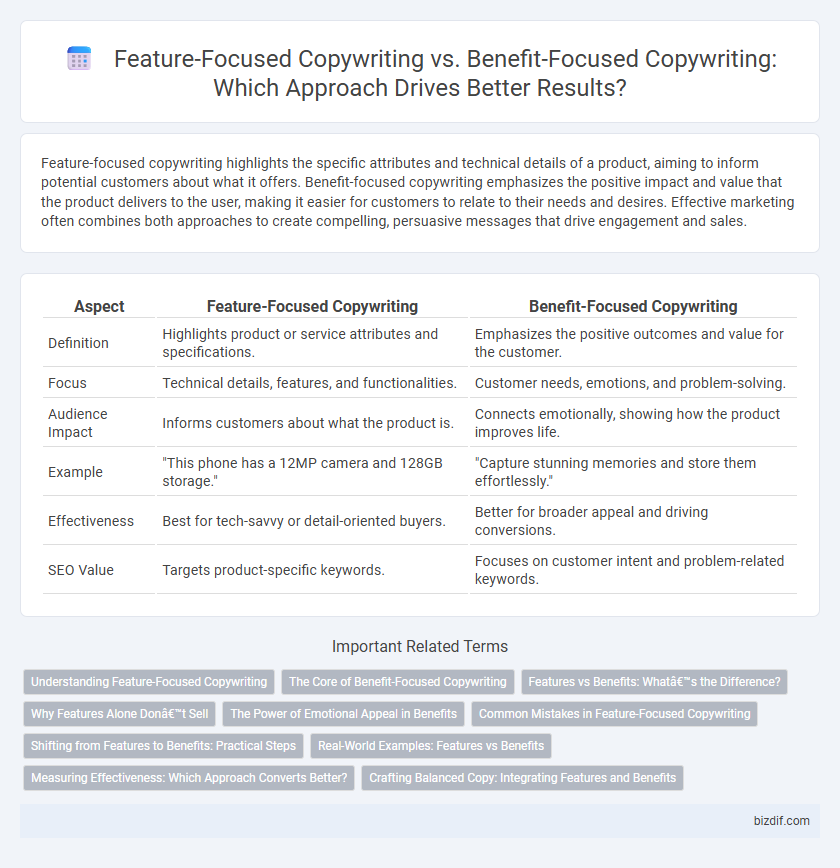Feature-focused copywriting highlights the specific attributes and technical details of a product, aiming to inform potential customers about what it offers. Benefit-focused copywriting emphasizes the positive impact and value that the product delivers to the user, making it easier for customers to relate to their needs and desires. Effective marketing often combines both approaches to create compelling, persuasive messages that drive engagement and sales.
Table of Comparison
| Aspect | Feature-Focused Copywriting | Benefit-Focused Copywriting |
|---|---|---|
| Definition | Highlights product or service attributes and specifications. | Emphasizes the positive outcomes and value for the customer. |
| Focus | Technical details, features, and functionalities. | Customer needs, emotions, and problem-solving. |
| Audience Impact | Informs customers about what the product is. | Connects emotionally, showing how the product improves life. |
| Example | "This phone has a 12MP camera and 128GB storage." | "Capture stunning memories and store them effortlessly." |
| Effectiveness | Best for tech-savvy or detail-oriented buyers. | Better for broader appeal and driving conversions. |
| SEO Value | Targets product-specific keywords. | Focuses on customer intent and problem-related keywords. |
Understanding Feature-Focused Copywriting
Feature-focused copywriting emphasizes the specific attributes and technical details of a product or service, such as size, materials, functionality, and performance metrics. This approach appeals to customers seeking clear, factual information to evaluate product capabilities and make informed decisions. Highlighting measurable features ensures transparency and establishes trust by showcasing what the product inherently offers.
The Core of Benefit-Focused Copywriting
Benefit-focused copywriting centers on addressing the customer's needs and desires by highlighting the positive impact a product or service will have on their life. Unlike feature-focused copywriting, which details product specifications, benefit-focused writing creates emotional connections by showcasing solutions and transformative outcomes. The core lies in translating features into clear, relatable advantages that drive purchasing decisions and enhance user satisfaction.
Features vs Benefits: What’s the Difference?
Feature-focused copywriting highlights the specific attributes and technical details of a product, such as size, materials, and capabilities, providing clear, factual information to the audience. Benefit-focused copywriting emphasizes the positive outcomes and emotional impact those features bring to the user, like convenience, time savings, or improved lifestyle. Understanding the difference helps marketers create persuasive content that either informs through features or motivates through benefits, aligning messaging with customer needs and decision-making processes.
Why Features Alone Don’t Sell
Features alone don't sell because they describe what a product is or has, failing to connect with the emotional and practical needs of the customer. Benefit-focused copywriting translates features into solutions that highlight how a product improves the user's life or resolves pain points. This approach increases engagement and conversion by making the value clear and relatable.
The Power of Emotional Appeal in Benefits
Benefit-focused copywriting harnesses the power of emotional appeal by highlighting how a product or service improves the customer's life, creating a stronger psychological connection. Unlike feature-focused copywriting, which details specifications, benefit-driven content taps into desires, fears, and aspirations, motivating action through relatable emotions. This emotional resonance significantly boosts engagement and conversion rates by making the message personally relevant to the audience.
Common Mistakes in Feature-Focused Copywriting
Feature-focused copywriting often falls into the trap of overwhelming readers with technical details that fail to connect with their needs, reducing engagement and conversion rates. Writers frequently neglect translating features into tangible benefits, which leaves the audience confused about the product's real value. Overemphasis on features without context can result in missed opportunities to create emotional appeal or solve customer pain points effectively.
Shifting from Features to Benefits: Practical Steps
Shift copywriting from features to benefits by identifying how product features fulfill customer needs and desires. Translate technical specifications into tangible outcomes, emphasizing emotional and practical advantages for the user. Use customer-centric language that highlights problem-solving and value creation to boost engagement and conversion rates.
Real-World Examples: Features vs Benefits
Feature-focused copywriting highlights specific attributes like product specifications, technical details, and unique functionalities, such as a smartphone's 48MP camera or 12-hour battery life. Benefit-focused copywriting translates those features into tangible outcomes that resonate with customers, like capturing professional-quality photos or uninterrupted use throughout the day. Real-world examples show that benefit-driven messaging typically boosts engagement and conversion by emphasizing how features improve the user's life rather than just listing product data.
Measuring Effectiveness: Which Approach Converts Better?
Measuring the effectiveness of feature-focused versus benefit-focused copywriting involves analyzing conversion rates, click-through rates, and customer engagement metrics. Benefit-focused copywriting consistently demonstrates higher conversion rates by clearly addressing customer needs and emotional triggers, whereas feature-focused copy may resonate better with technical audiences seeking detailed product specifications. A/B testing campaigns that compare both approaches provide actionable data, revealing that benefit-driven messages generally outperform feature-centric ones in driving sales and fostering brand loyalty.
Crafting Balanced Copy: Integrating Features and Benefits
Crafting balanced copy involves seamlessly integrating product features with their corresponding benefits to address customer needs effectively. Highlighting technical specifications alongside tangible outcomes enhances credibility while resonating with the audience's motivations. This strategic synergy boosts engagement, drives conversions, and elevates overall marketing performance.
Feature-Focused Copywriting vs Benefit-Focused Copywriting Infographic

 bizdif.com
bizdif.com